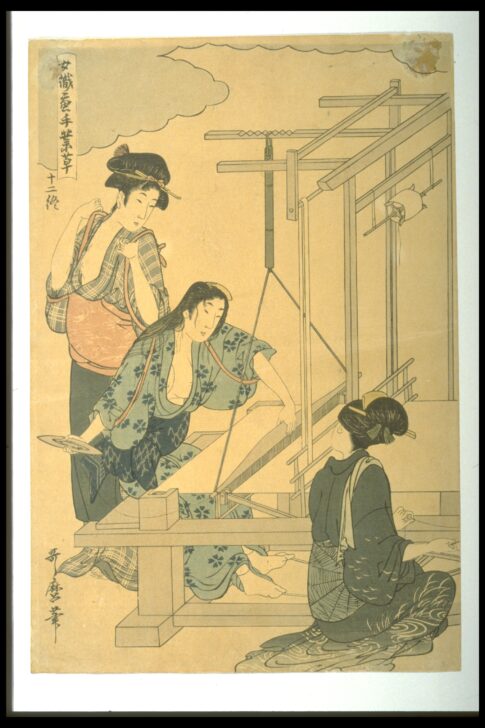Women’s Occupations: Sericulture (1 of a series of 12 prints): weaving
Kitagawa Utamaro

Description
Women of all occupations was a popular theme in woodblock prints of the eighteenth and early nineteenth centuries. Kitagawa Utamaro, one of the leading artists of Edo (modern Tokyo), renders this version with mildly erotic overtones. This image is the twelfth and last in a series depicting women making silk.
This reproduction of a famous print tells us much about textiles for urban commoners at time. The seated woman spinning thread wears a green kosode (short-sleeved kimono) with a paste-resist landscape design. Her companion at the loom wears an indigo-dyed robe with an overall stencil-print design of stylized blossoms, and the standing figure wears a simple woven plaid. Cotton textiles dyed in these techniques were the most common for everyday wear in the cities.
Exhibited in "Japanese Costumes & Ceramics, Past & Present," October 2001-February 2002. Maribeth Graybill, Senior Curator of Asian Art
Subject Matter:
The label copy details most of the subject matter.
Kitagawa Utamaro was a famous ukiyo-e artist who was renowned for his bijin okubi-e or large-headed beauties.
Physical Description:
This color print depicts three women. One woman on the left watches and stands over the woman weaving at the machine. Another woman on the right kneels and watches, the viewer only sees her back. They all wear differently patterned kimonos and the two women on the left have their's open. The background is bare and only includes a cloud outline at the top. The machine the women are around takes up much of the print. On the top left is an inscription in a box followed by another inscription. There is an inscription in the bottom left as well.
Usage Rights:
If you are interested in using an image for a publication, please visit https://umma.umich.edu/request-image/ for more information and to fill out the online Image Rights and Reproductions Request Form.